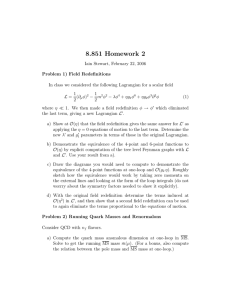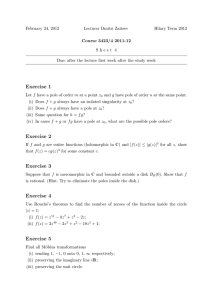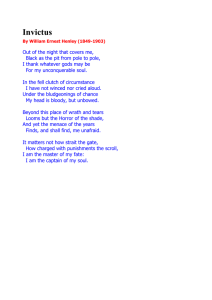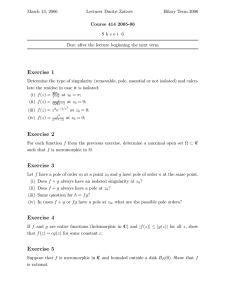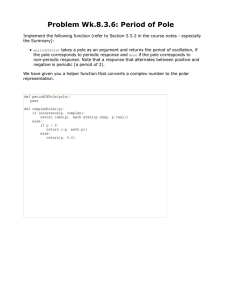8.851 Homework 2
advertisement
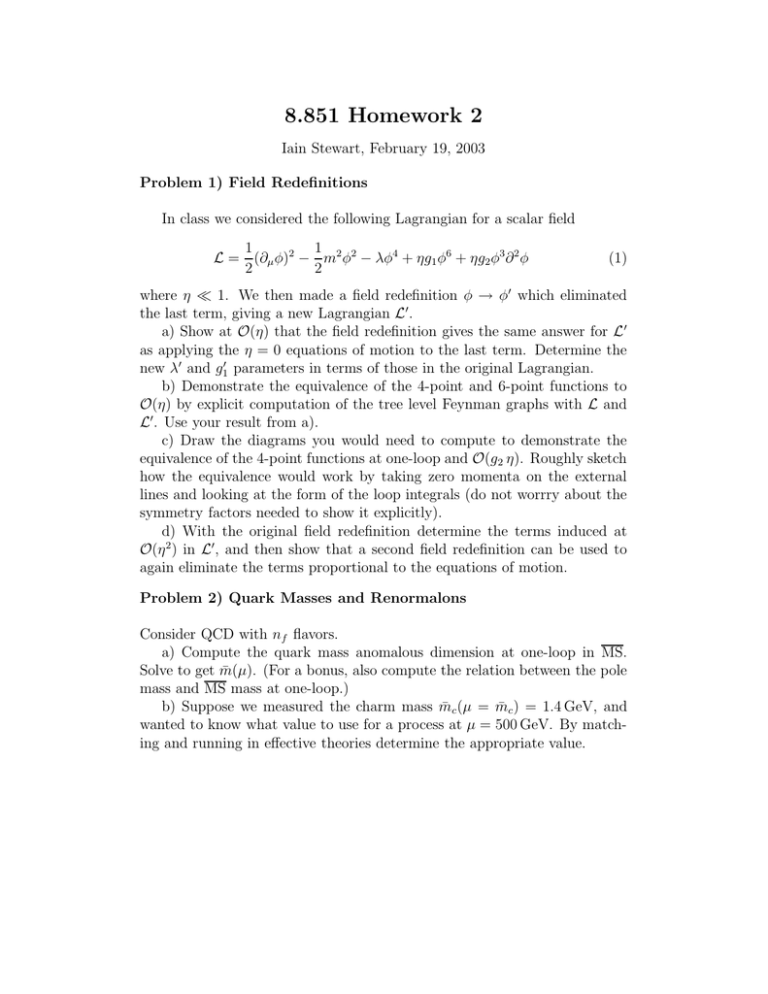
8.851 Homework 2
Iain Stewart, February 19, 2003
Problem 1) Field Redefinitions
In class we considered the following Lagrangian for a scalar field
1
1
L = (σµ λ)2 − m2 λ2 − γλ4 + �g1 λ6 + �g2 λ3 σ 2 λ
2
2
(1)
where � � 1. We then made a field redefinition λ � λ� which eliminated
the last term, giving a new Lagrangian L� .
a) Show at O(�) that the field redefinition gives the same answer for L�
as applying the � = 0 equations of motion to the last term. Determine the
new γ� and g1� parameters in terms of those in the original Lagrangian.
b) Demonstrate the equivalence of the 4-point and 6-point functions to
O(�) by explicit computation of the tree level Feynman graphs with L and
L� . Use your result from a).
c) Draw the diagrams you would need to compute to demonstrate the
equivalence of the 4-point functions at one-loop and O(g2 �). Roughly sketch
how the equivalence would work by taking zero momenta on the external
lines and looking at the form of the loop integrals (do not worrry about the
symmetry factors needed to show it explicitly).
d) With the original field redefinition determine the terms induced at
O(� 2 ) in L� , and then show that a second field redefinition can be used to
again eliminate the terms proportional to the equations of motion.
Problem 2) Quark Masses and Renormalons
Consider QCD with nf flavors.
a) Compute the quark mass anomalous dimension at one-loop in MS.
Solve to get m(µ).
(For a bonus, also compute the relation between the pole
¯
mass and MS mass at one-loop.)
¯ c (µ = m
¯ c ) = 1.4 GeV, and
b) Suppose we measured the charm mass m
wanted to know what value to use for a process at µ = 500 GeV. By match­
ing and running in effective theories determine the appropriate value.
In QCD the pole mass has an infrared renormalon which leads to an
intrinsic ambiguity in its value. This ambiguity is related to the convergence
of perturbative series with terms ηsn where the coefficients may grow as n!.
�
If a function f (ηs ) = f (0) + n�0 fn ηsn+1 then the convergence is improved
for the Borel transformed function f˜(t) where
f˜(t) = f (0)∂(t) +
�
fn n
t ,
n=0 n!
f (ηs ) =
�
�
dte−t/�s f˜(t) .
(2)
0
For the fermion self energy a unique set of diagrams, G, are proportional
to ηs [nf ηs ]k for k � 1 (draw them). They can be used to examine the
renormalon by looking at their contribution to the pole mass.
c) Examine Eq.(4.73) and (4.74) of the text. Using the result, compute
the Borel transform of the graphs in G for the pole mass to arrive at the
form in Eq.(4.78) of the text. (Subtract by hand the pole at u = 0 which
corresponds to an ultraviolet renormalization.)
d) The pole at u = 1/2 is called an infrared renormalon. It makes the
inverse Borel transform in Eq.(2) ambiguous, and shows that the pole mass
is sensitive to infrared momenta. (The MS mass is a short distance mass and
does not have a renormalon ambiguity.) Compute the size of the ambiguity,
∂mpole , from the ambiguity in deforming the contour in the integral in Eq.(2)
to avoid the u = 1/2 pole. Express your answer in terms of �QCD .
Problem 3) b � s� and QCD Equations of Motion
After integrating out the top, W, Z, and Higgs, local operators are induced
which mediate the flavor changing charge neutral process b � s�. The
operators that are induced include 4-quark operators and the following ten
2-quark operators:
Q1 = s̄L D
/Dµ D µ bL ,
1
Q2 = s̄L Dµ D
/D µ bL − s̄L Dµ D µ D
/ bL ,
2
Q3 = s̄L Dµ D
/D µ bL ,
Q4 = s̄L D/D
/D/ bL ,
a
Q5 = gs̄L T a � µ bL D � Gµ�
,
a
a µ �
Q6 = gGµ� s̄L T � D bL ,
Q7
Q8
Q9
Q10
=
=
=
=
g G̃aµ� s̄L T a � µ D � bL ,
emb s̄L � µ� bR Fµ� ,
gmb s̄L � µ� T a bR Gaµ� ,
mb s̄L D
/D
/ bR
(3)
where Dµ = σµ + igT a Aaµ + ieQAµ and Q is the charge operator.
a) Write down the QCD equations of motion for the gluons and for the
quark fields bL , bR , and sL .
b) Take ms = 0, but keep the b-quark mass mb ≥= 0. Use the equations
of motion to reduce all the operators to linear combinations of Q8 and Q9
plus 4-quark operators. (You do not need to write the 4-quark operators out
explicitly, but do write “+ 4-quark” to indicate when your manipulations
have induced them.) You may find identities like 2D µ = {� µ , D
/} useful. For
Q7 you will need the identity for three gamma matrices, Eq.(1.119) in the
text.
c) Write down the Feynman rule for Q8 .
